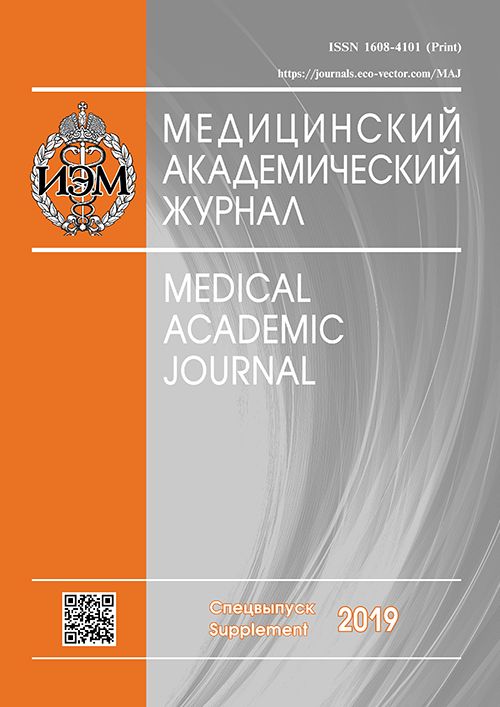PROTEASOME MECHANISMS OF THE DEVELOPMENT OF TOLERANCE TO ALLOGRAFT IN WISTAR AND AUGUST RATS WITH DIFFERENT CONTENT OF MONOAMINES IN THE BRAIN
- Authors: Astakhova TM1, Karpova Y.D1, Bozhok GA2, Alabedal’karim NM2, Lyupina Y.V1, Legach EI2, Sharova NP1
-
Affiliations:
- Koltzov Institute of Developmental Biology, Russian Academy of Sciences
- Institute of Problems of Cryobiology and Cryomedicine, National Academy of Sciences of Ukraine
- Issue: Vol 19, No 1S (2019)
- Pages: 39-41
- Section: Articles
- URL: https://journals.eco-vector.com/MAJ/article/view/19314
- ID: 19314
Cite item
Full Text
Abstract
Full Text
Introduction. Induction of donor-specific tolerance (DST) by infusion of donor cells into portal vein of a recipient 7-14 days before grafting a tissue is the effective approach to prolong the life of a graft [1]. Molecular mechanisms of DST development are still poor studied. We showed earlier that in inbred August rats the enhanced expression of liver immune proteasomes with LMP2 subunit was related to the survival of ovarian allograft [2]. Inbred August rats are known to have the increased level of monoamines and stress limiting systems in the brain in comparison with outbred Wistar rats [3]. The aim of the present work was to compare proteasome mechanisms of the development of DST to ovarian allograft in August and Wistar rats being under different stress conditions of the central nervous system. Material and methods. Ovarian grafts from neonatal Wistar and August rats were transplanted to 5-6-month-age female August rats (n = 10) and Wistar rats (n = 10), correspondingly, as earlier described [2] with the exception of preliminary ovariectomy. DST was induced in every rat group 7 days before ovarian grafting as described previously [2]. False-operated animals (intraportal infusion of pure physiological saline solution and simulation of grafting) (n = 5) were used as a control. All manipulations on animals were performed in accordance with the European Convention on the Protection of Vertebrate Animals used for Experimental and Other Scientific Purposes (Strasburg, 1986). Detection of proteasome subunit content was performed by Western blotting in accordance with protocol published previously [3]. Results and discussion. In spite of DST induction, the tolerance to allografts was not developed in all cases. In 7 of 10 Wistar rats and 4 of 10 August rats, the ovarian tissue survived to 39 day after its grafting. Stress conditions due to the enhanced monoamine level in the brain are likely to be related to not-so-effective DST development and engraftment in August rats as in Wistar rats. The content of proteolytic immune subunits LMP7 and LMP2 and subunits Rpt6 and PA28α belonging to proteasome activators PA700 and PA28αβ, correspondingly, in the liver of all groups of rats was studied (fig. 1, table 1). In the liver of all rats with survived allografts, LMP2 content was significantly higher, while in the rats with rejected allografts it was lower than in control rats. Importantly, these differences were more pronounced in Wistar rats. LMP7 content in the liver did not differ between all groups of animals. The level of PA28αβ activator was increased and the level of PA700 activator was decreased in the liver of August and Wistar rats with survived allografts compared to control. Conclusion. Thus, the development of DST is connected with the enrichment of liver proteasome pool by immune proteasomes containing LMP2 subunit and PA28αβ activator, which may be important for inhibition of T lymphocyte function. Rebuilding of liver proteasome pool is partially suppressed in August rats by stress condition of their central nervous system. Acknowledgments. This work was funded by RFBR (grant No. 16-34-60083-mol_a_dk) and Government Program of Basic Research (No. 0108-2018-0002).About the authors
T M Astakhova
Koltzov Institute of Developmental Biology, Russian Academy of Sciences
Ya D Karpova
Koltzov Institute of Developmental Biology, Russian Academy of Sciences
G A Bozhok
Institute of Problems of Cryobiology and Cryomedicine, National Academy of Sciences of Ukraine
N M Alabedal’karim
Institute of Problems of Cryobiology and Cryomedicine, National Academy of Sciences of Ukraine
Yu V Lyupina
Koltzov Institute of Developmental Biology, Russian Academy of Sciences
E I Legach
Institute of Problems of Cryobiology and Cryomedicine, National Academy of Sciences of Ukraine
N P Sharova
Koltzov Institute of Developmental Biology, Russian Academy of Sciences
References
- Karpova YaD, Bozhok GA, Alabedal’karim NM, et al. Proteasomes and transplantology: Current state of the problem and the search for promising trends. Biology Bulletin. 2017;44(3):237-244.
- Karpova YaD, Bozhok GA, Lyupina YuV, et al. Changes in the proteasome function after Induction of donor-specific tolerance in rats with ovarian allograft. Biology Bulletin. 2012;39(3):244-249.
- Erokhov PA, Lyupina YuV, Radchenko AS, et al. Detection of active proteasome structures in brain extracts: Proteasome features of August rat brain with violations in monoamine metabolism. Oncotarget. 2017;8:70941-70957.
Supplementary files








